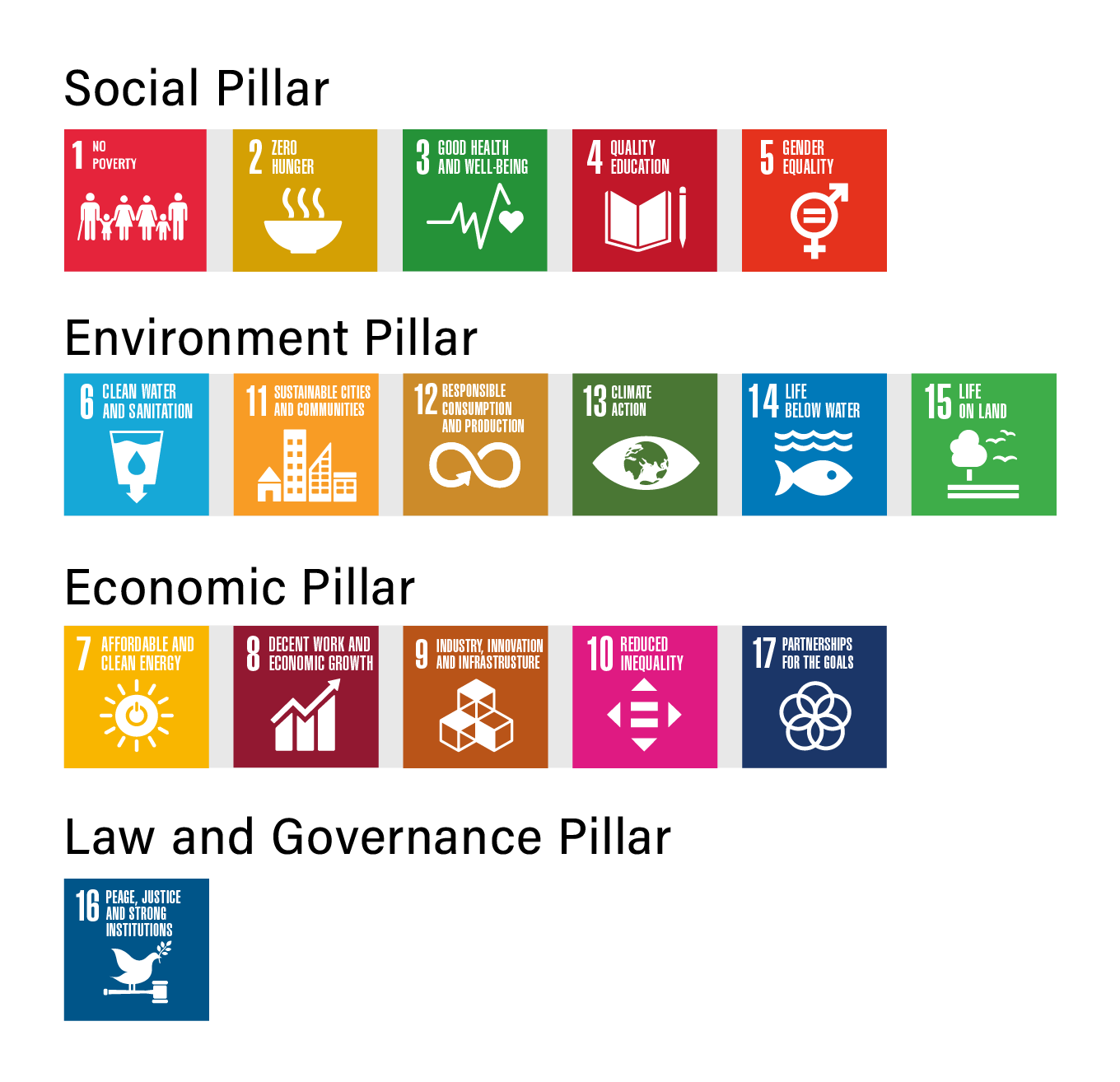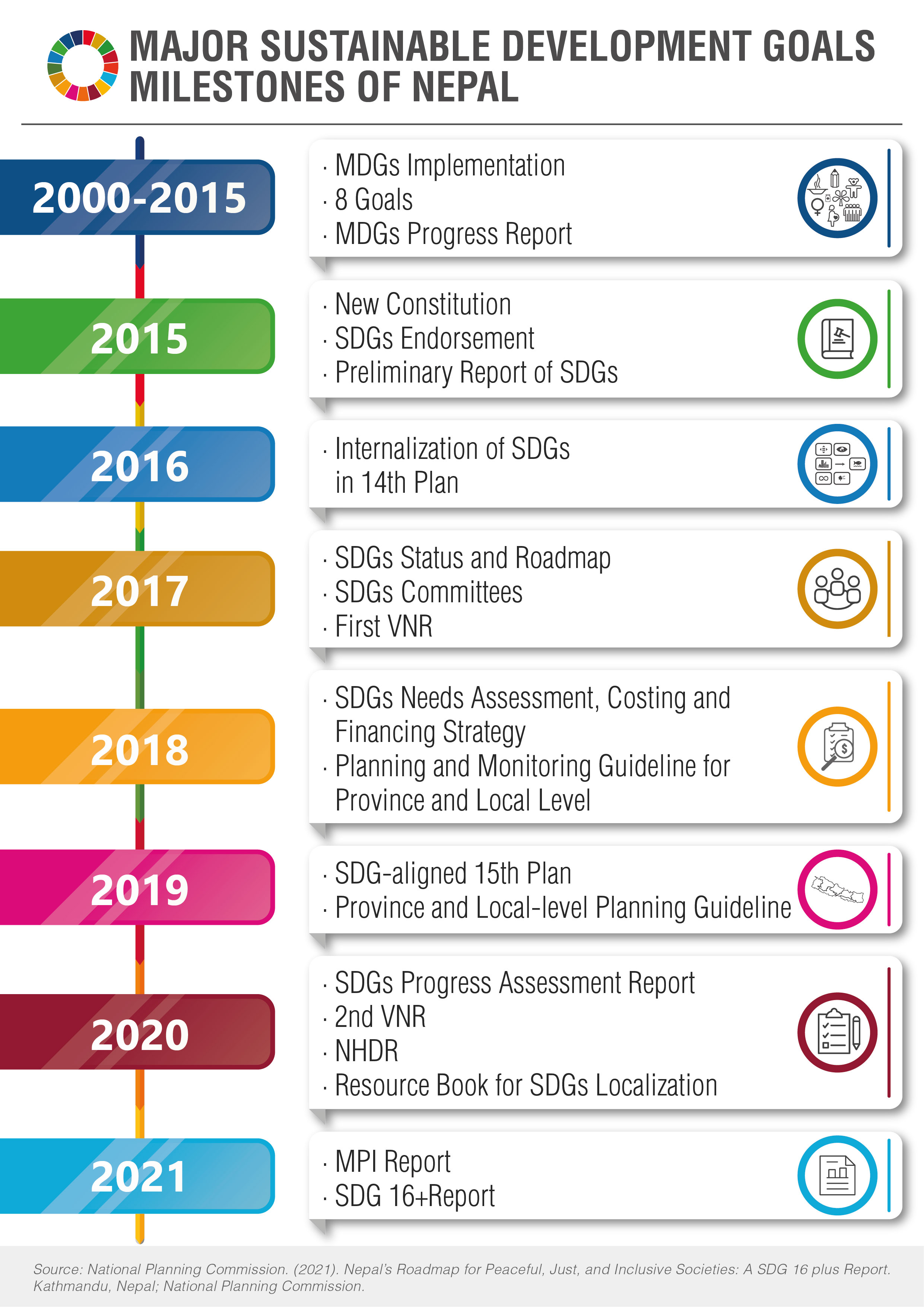ABOUT THE SDGs IN NEPAL
The National Planning Commission’s Sustainable Development Goals (SDGs) Platform
Nepal signed the 2030 Sustainable Development Agenda agreed by the Members of the United Nations. The Agenda sets out 17 goals that define global sustainable development priorities and aspirations to achieve by 2030 and seek to mobilize global efforts around a common set of goals and targets. Nepal, as a member of the UN, is committed to the SDGs.
This National SDGs platform of the National Planning Commission (NPC) is intended to present tracking of Nepal’s progress towards achieving the SDGs by 2030 and other national development goals. The platform provides information about the Government of Nepal’s efforts in terms of planning, implementation, and monitoring in relation to the SDGs. The platform also serves as an online data and repository to monitor the progress in the implementation and achievements of SDGs.
The Sustainable Development Agenda 2030
The SDGs, also known as Global Goals, are built on the success of the Millennium Development Goals (MDGs).The 2030 Agenda for Sustainable Development — adopted by world leaders in September 2015 at a historic UN Summit — officially came into force on 1 January 2016. One hundred and ninety-three countries adopted a set of 17 goals to end poverty, protect the planet and ensure prosperity for all, as part of a new sustainable development agenda. Each goal has specific targets to be achieved over the period of fifteen years by 2030. The SDGs are unique in that they call for action by all countries (poor, rich and middle-income) to promote prosperity. They recognize that ending poverty must go hand-in-hand with strategies that build economic growth and addresses a range of social needs including education, health, social protection, and job opportunities while fight inequalities to ensure that no one is left behind.
SDGs are broadly divided into four groups as Social, Environment, Economic and Law and Governance Pillars and exhibited as follows (United Nations, 2015)

Nepal’s National Sustainable Development Goals Framework
While the SDGs are not legally binding, governments are expected to take ownership and establish national frameworks for the achievement of the 17 Goals. Nepal has prepared its SDG country Status Report in 2015, detailing and taking stock of its development context and establishing the baseline for the SDGs. This made Nepal the first country in the world to publish its SDG Country Report and symbolizes Nepal’s commitment and readiness to execute the SDGs. The National Planning Commission is the designated focal agency of the Government of Nepal for SDG localization. The NPC has been working to align its periodic plans with the SDG and its targets including its national monitoring and evaluation framework. The internalization of SDGs started since the 14th periodic plan (2016/17-2018/19). The current 15th Plan (2019/20-2023/24) is also fully aligned with the SDGs. Moreover, other sectoral plans, policies and targets are also aligned with the SDGs. Specific SDG codes are assigned for all national programs in the national budget.
The SDGs are also aligned with Nepal’s long-term vision ‘Prosperous Nepal: Happy Nepali’ to be achieved by 2043. The 15th Plan is anchored on the vision to graduate from the least developed country status; eradicate multidimensional poverty; attain the SDGs; reach the level of a middle-income country by 2030 and achieve all round prosperity and happiness by 2043. Prosperity includes four goals viz. accessible modern infrastructure; full utilization of human capital potential; high and sustainable production and productivity; and high and equitable national income. Similarly, Happiness includes six goals viz. well-being and decent life; safe, civilized and just society; balanced environment; good governance; strengthened democracy and national unity; and security and dignity.
Three high-level committees have been formed to help implement SDGs i.e. a Steering Committee chaired by the Rt Hon Prime Minister; a Coordination and Implementation Committee chaired by the Vice Chairman of the NPC and seven thematic committees are headed by NPC members.
Nepal is one of the members of the group of countries that have agreed to submit its Voluntary National Review of its progress towards the SDGs and it has already presented two such reports at the High-Level Political Forum (HLPF), under the auspices of the United National Economic and Social Council (ECOSOC). Further, it is implementing SDGs following its SDG Status and Road Map (2016-2030) through its national policies and programs. The Roadmap has identified 494 indicators under 169 targets spread across the all sectors. The Roadmap is supported by another milestone document i.e. SDG Needs Assessment, Costing and Financing Strategy2018. Nepal has identified an average annual investment requirement of Nepalese Rupees 2024.8 billion (approx. US$ 20 billion) to implement the SDGs with a 29 percent financing gap.
Download National SDG Framework
Nepal’s Progress Towards the SDGs
The overarching goal of the SDGs of ‘leaving no one behind’ fits well with the inclusive political order that Nepal has been building with the new Constitution (2015), which aspires to create a prosperous, egalitarian and pluralistic society, and serves as the overarching guide to all development policies, plans, and programs. Nepal's social and political progress has been highly progressive:
Building on the gains so far, the challenge for Nepal is to swiftly embrace a much more ambitious aspiration of fulfilling the SDGs. However, the country is resource constrained, and it needs to forge a diverse partnership for SDGs among government, business and civil society to end poverty and create a life of dignity and opportunity for all in Nepal.
